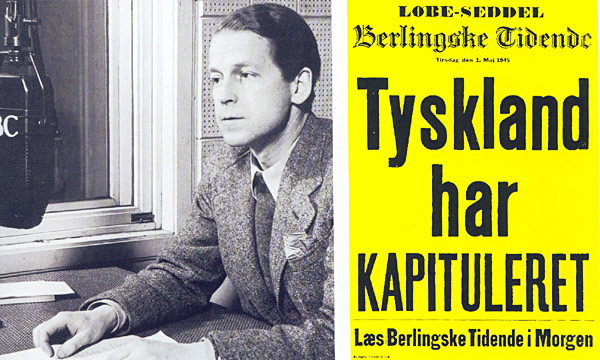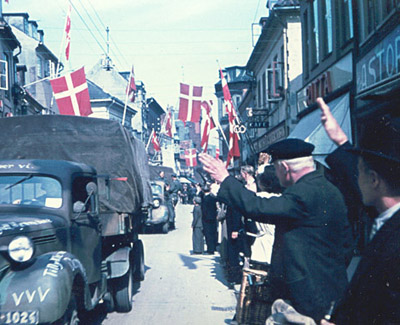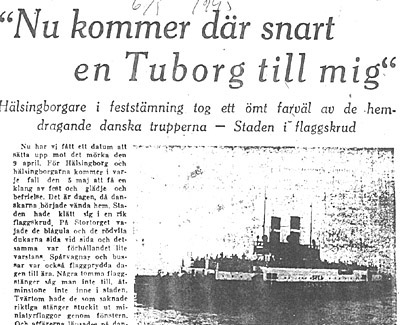| Befrielsen

| | Den 4. maj om aftenen sendte BBC budskabet om at tyskerne havde overgivet sig i bl.a. Danmark fra den 5. maj kl. 8 om morgenen. Jubelscener brød ud og Den Danske Brigade i Sverige blev færget over fra Helsingborg til Helsingør. Her stod Helsingørs borgmester "Kong Peder" klar til at modtage dem.
Samtidig trådte de danske militære ventegrupper i aktion med bevogtningsopgaver |
Befrielsen - Danmark

| | Den 4. maj 1945 om aftenen meddeltes det i radioen, at tyskerne havde overgivet sig med virkning fra næste morgen.
I alle byerne strømmede folk ud på gaderne.
Umiddelbart efter startede et bittert opgør med dem, man mente, der havde samarbejdet med tyskerne. |
Befrielsen-Danmark
Den 4. maj om aftenen sendte BBC budskabet om at tyskerne havde overgivet sig i bl.a. Danmark fra den 5. maj kl. 8 om morgenen.

Frihedsbudskabet fra London |
| |
 | | Stor | Søslaget i Øreund |
Befrielsesaftenen, den 4. maj 1945 set fra Helsingør
Den 4.maj lød frihedsbudskabet i BBC.s sædvanlige radioavis kl.20,30 til Danmark. Tyskerne havde kapituleret - dog ikke i Norge, og kapitulationen skulle gælde fra næste dag, lørdag den 5.maj kl. 8 om morgnen. Som overalt i Danmark flåede folk i Helsingør mørklægningsgardinerne fra vinduerne, tændte lys og strømmede i en glædesrus ud på gaderne. I den lokale biograf stoppede man filmen, for at folk kunne deltage i gadens jubel
Tysk overgivelse uden kamp?
I nattens løb var der hektisk aktivitet hos modstandsbevægelsen og de militære ventegrupper i Helsingør samt samarbejdspartnerne i Sverige. Situationen var spændt til det sidste. Bl.a. fordi man ikke vidste, hvordan de tyske tropper i Danmark ville reagere på ordren om overgivelsen. På Kronborg var der eksempelvis stationeret ca.3000 tyske soldater med kanoner og andet svært skyts.
Usikkerheden og forvirringen om dette blev på tragisk vis anskueliggjort i den sydlige del af Øresundsregionen, Bornholm, hvor den tyske kommandant nægtede at overgive sig til russerne. Dette medførte et ødelæggende og –fra alle sider erkendt- unødvendigt russisk bombardement af Rønne og Nexø.
Strategisk kerneområde
Både Helsingborg og Helsingør var centrale strategiske områder. For Helsingborg drejede det sig om den kæmpestore organisatoriske opgave, på få timer, at få samlet Den Danske Brigade (Danforce) fra destinationerne i Småland og lejrene nord for Stockholm, til det centrale udskibningssted, Helsingborg.
Det var først sent blevet besluttet, at der var herfra Den Danske Brigade skulle sendes af sted, og at de skulle landsættes i Helsingør. Der skulle også træffes beslutning om, i hvilket omfang det svenske militær skulle sættes ind til støtte for landgangen på Sjællands østkyst.

Svenske generaler siger farvel |
Befrielsesdagen, den 5. maj 1945
Først i nattens løb fik Byledelsen at vide, at Den Danske Brigade havde fået ordre til at gå i land i Helsingør. I løbet af aftenen, den 4.maj havde Byledelsen opslået hovedkvarter på bryggeriet Wiibroe og kl. 4 ophørte den tyske patruljering i gaderne. Kl. 8 hejste de tyske skibe i havnen fredsflag, og overalt i Helsingør gled Dannebrog (det danske flag) til tops akkompagneret af kirkernes klokker.
Om morgnen den 5.maj havde Byledelsen i Helsingør, fået ordre fra Frihedsrådet og den illegale militære ledelse i Danmark, om at koncentrere sig om følgende:
- Helsingør havn skulle ryddes for tyske spærringer
- Sikkerhed for, at tyskerne fra det stærkt befæstede Kronborg ikke ville beskyde Brigaden på vej over Sundet
Opgaven blev løst således:
- Kl.8,50 havde modstandsbevægelsen afvæbnet de tyske poster ved ved færgelejet
- Kl. 9,00 besattes havnen med 15 bevæbnede og 50 ubevæbnede modstandsfolk
- Kl. 9,00 Havde Byledelsen og Borgmester Peder Christensen, forhandlet en aftale i stand med den tyske kommandant på Kronborg om at Brigaden frit kunne lande i Helsingør.
Kl.11,30 Landede de første tropper fra Brigaden i Helsingør Havn, uden problemer.

Plakat om besættelsens ophør | 
Den militære byledelse i Helsingør | 
Ventegrupperne går i aktion |
Brigadens ankomst
Den 4. maj kom ordren fra den socialdemokratiske statsminister, Vilhelm Bull om, at Brigaden skulle komme hjem. Tyskerne havde overgivet sig. I en stor opsamlingslejr ved Helsingborg samledes de danske lejre i Sverige og om formiddagen, den 5.maj 1945, blev der sat kurs mod Helsingør i en flåde bestående af næsten alt der kunne holdes flydende under den 4 km lange overfart.
Ved afgangen var der stor festivitas og ved ankomsten til Helsingør, var den populære socialdemokratiske Borgmester Peter Christiansen mødt op og holdt en bevæget velkomsttale. Turen gik senere til København, hvor 3 af Brigadens menige blev myrdet og 13 såret af Hipos snigskytter under en noget amatøragtig og uansvarlig tilrettelagt indmarch.

Brigaden på vej | 
Brigadens hjemkomst til Helsingør | 
Borgmesteren tager imod | 
Helsingør den 5 maj 1945 |
Happy end
Brigadens ankomst 5.maj 1945, medførte nye jubelscener, og de følgende dage var byen domineret af Brigadens og modstandsbevægelsens folk. Samtidig kom det til en række sammenstød mellem danskerne, tyskerne og deres danske håndlangere. Retsopgøret begyndte på befrielsesdagen.
Man kan sige, at befrielsesdagen i Helsingør endte lykkeligt, selvom der blev givet udtryk for stærke følelser overfor tyske flygtninge, tyske soldater og de danskere, der havde samarbejdet med tyskerne. I Skåne blev befrielsen også hilst med glæde, selvom det var en stor organisatorisk udfordring for myndighederne og de mange civile hjælpere.

Sveasøjlen | 
De fire inskriptioner |
Befrielsen - Sverige

| | ”Kommer der ikke snart en Tuborg til mig” er en populær dansk drikkevise, som Helsingborgs Dagblad, den 6 maj 1945, citerede de første linier fra på sin forside. Der var feststemning! |
Befrielsesbudskabet skabte jubel i Helsingborg. Den danske Brigades ankomst og afrejse til Helsingør samt de mange civile flygtninges glæde over at kunne komme hjem satte sit præg på Helsingborg.
Flygtningestrømmen
I krigens sidste tid øgedes flygtningestrømmen til Skåne betydeligt. Det skyldtes bl.a. Folke Bernadottes forhandlinger, som muliggjorde at mange fanger fra koncentrationslejrene kunne løslades og sendes til Sverige. Størstedelen af disse transporter passerede København og Malmö og de løsladte fanger blev anbragt i forskellige lejre i Skåne. Malmö og Helsingborg var mellemstationer og i Helsingborg blev Ramlösa brugt som gennemgangslejr. Kurstedet var selvsagt ikke tilstrækkeligt og derfor måtte man bruge alt hvad der kunne anvendes af skoler, industrilokaler og hoteller. 16 000 flygtninge ankom til Skåne på mindre end en måned. Det krævedes en omfattende organisation for at tage sig af alle flygtninge. Alle var nødt til at gennemgå sundheds- og sikkerhedskontrol. Alle skulle ha tøj og mad.
Flaget til tops for Danmark
”Nyheden at Danmark atter er frit fejres, i særdeleshed af alle helsingborgere, med den allerstørste glæde. For at vise vores glæde og som en hyldest til et frit Danmark må flaget i dag gå til tops på hver flagstang i Helsingborg.”
Disse ord kunne læses på ledersiden i Helsingborgs Dagblad den 5. maj 1945. Allerede aftenen før havde nyheden om Danmarks frihed nået Helsingør. Når den sidste færge afgik til Helsingborg om aftenen den 4. maj, stod helsingoranerne forsamlet på kajen og råbte: ”Hils dem derovre!”

Fredsbudskabet i Sverige | 
Helsingborgs Dagblad, 6. maj 1945 |
Tusinder af helsingborgere ved frihedsbål
Om aftenen den 5. maj var tusinder af mennesker forsamlet ved ”Fria bad”, nord for byens centrum. Et fakkeltog tændte et gigantisk frihedsbål på stranden. Man ville sende en frihedshilsen til Danmark. Adskillige gange under krigen var bål blevet tændt for at sende en hilsen til de okkuperede dansker. Nu ville man hilse freden på samme måde.
Tidligere på dagen havde hele byen fulgt avisernes opfordring om at hejse flaget og overalt så man svenske og danske flag. Tusinder af mennesker var samlet i havnen for at sige farvel til de første hjemvendende danske tropper, uddannede i Sverige. Det var startskuddet til en lang strøm af hjemvendende danskere. En taksigelsesgudstjeneste blev afholdt i Gustav Adolfs-kirken. Kirken var fyldt op til sidste plads.

Fredsgudstjenester |
Norges frihed også fejret i Ramlösa
Sammen med glæden over Danmarks befrielse ventede man nu også på Norges frihed. Da den så kom, var lykken fuldstændig, ikke mindst i Ramlösa-lejren, hvor mange nordmænd var indkvarteret. I lejren viste man også sin taknemmelighed overfor de politifolk i Helsingborg, som hele tiden trofast havde støttet flygtningene.
Også denne gang blev en fredsgudstjeneste afholdt i Gustav Adolfs-kirken ved den dynamiske og populære sognepræst Gunnar Stenberg.

Fest i Ramlösa |
Kæmpemæssig transportopgave
Ved krigens slutning befandt sig over 100 000 ikke-svenskere i Sverige. En del blev i landet men de fleste skulle transporteres hjem. En minutiøs planlægning blev igangsat. Alle kunne jo ikke rejse samtidigt, eller over den samme havn. Helsingborg, Malmö og Trelleborg blev efter krigen passeret af mange tusinder hjemvendende flygtninge. Således vendte bl.a. Bruno Kreisky hjem til Østrig og Willy Brandt til Vesttyskland.
Men det var ikke bare flygtninge der skulle hjem. Tyske soldater og russiske krigsfanger i Norge skulle også sendes gennem Sverige. I løbet af 1945 blev 122 000 soldater transporteret, og en stor del af de tyske soldater måtte passere Skåne. Også her var detaljeret planlægning påkrævet, ikke mindst af sikkerhedsmæssige grunde. Et tragisk kapitel udgjordes af de baltere, som blev tvunget ud af Sverige, da Sovjetunionen stillede krav om, at de som havde deltaget i krigen imod Sovjet, skulle udleveres. Dramatiske og tragiske scener udspilledes i Trelleborg, da balterne blev tvunget ombord på færgen til en usikker og mørk fremtid.
Göte Friberg hyldet
Få uger efter befrielsen kom socialminister Gustaf Möller til Helsingborg. Han skulle afsløre en mindesten og ved den efterfølgende middag på Grand Hotel hyldede han politikommissær Friberg, som en mand man kunne stole på. (Möller og Friberg fik modtog beggeen udmærkelse fra den danske frihedsbevægelse for deres indsats under krigen.) Da Danmark trængte til hjælp var der brug for pålidelige personer.
Möller fortalte under spisningen, at Sverige under krigenbl.a. havde besluttet at sende en million patroner til Danmark. Da man i Stockholm overvejede hvordan dette kunne gennemføres uden at tyskerne opdagede noget, blev svaret på ministerniveau: ”Det er såre simpelt, vi meddeler bare Friberg i Helsingborg.” Selvfølgelig blev transporten en succes. Möller erklærede også, at regeringen nu, bagefter, burde godkende ”alt det som er sket her i Helsingborg hvad gælder skjulte transporter til og fra Danmark”, og som regeringen ikke har kunnet eller nået at godkende.
Man kan godt spørge om samhørigheden nogensinde har været større i Øresundsregionen, end den var i maj måned år 1945.

Göte Friberg | 
Göte Friberg |
|